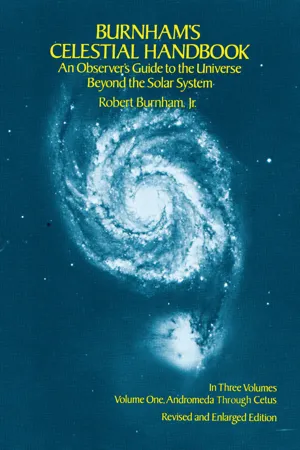Physics
Stellar Spectral Classes
Stellar spectral classes are a classification system used to categorize stars based on their spectral characteristics. The system is based on the temperature of the star's surface, which is determined by the wavelengths of light that it emits. The classes range from O (hottest) to M (coolest).
Written by Perlego with AI-assistance
Related key terms
Related key terms
1 of 4
Related key terms
1 of 3
4 Key excerpts on "Stellar Spectral Classes"
- eBook - ePub
Burnham's Celestial Handbook, Volume One
An Observer's Guide to the Universe Beyond the Solar System
- Robert Burnham(Author)
- 2013(Publication Date)
- Dover Publications(Publisher)
Red; resembles type M, but titanium oxide bands are replaced by zirconium oxide. Complex spectra, usually variable, with hydrogen emission lines. Example = R Cygni.WWolf-Rayet Stars; hot blue giants, high temperatures and luminosities, resemble 0-type, but show broad emission features caused by expanding gaseous shell, extremely turbulent atmospheres. Temperature 50,000°K and higher. Example = Gamma Velorum.Stellar Spectral ClassesThe vast majority of stellar types may be arranged in a logical sequence, each spectral class gradually merging into the next. The chief classes now recognized are identified by the letters 0, B, A, F, G, K, and M. Each class contains ten subdivisions numbered from 0 to 9. Thus a “B5” star is approximately midway between B0 and A0. The classes define a temperature sequence—or color sequence—which amounts to the same thing. Stars of type 0 and B are blue-white; A stars are white; F and G stars are yellowish; K stars are orange, and M stars are red. Three additional classes, R, N, and S, are used for stars which resemble type M but show certain spectral differences, as described in the short summary on the opposite page. Stars of type N are the reddest known.Prefixes and suffixes are often used to further define the status of a star. Some typical examples are:dM2 Prefix “d” indicates ordinary dwarf star. gM5 Prefix “g” indicates giant star. DA Prefix capital “D” indicates white dwarf star (degenerate star). B2e Suffix “e” indicates emission spectrum, bright lines replacing certain dark absorption lines. A5p Suffix “p” indicates spectral peculiarities. As we study the spectral series from type 0 to type M, we find a gradual increase in the number and complexity of the spectral lines and bands, the cooler stars showing by far the richest spectra. This does not necessarily imply any fundamental difference in chemical composition, but is largely the effect of temperature. In the cool N-type stars, for example, we find rich banded spectra produced by carbon compounds in the atmosphere of the star; these would be destroyed by significantly higher temperatures. The spectral features depend not only upon the elements present, but also upon the temperature. Thus the interpretation of stellar spectra is a complex study, and many stars display spectral peculiarities which still defy explanation. - eBook - ePub
- David A. Weintraub(Author)
- 2010(Publication Date)
- Princeton University Press(Publisher)
Figure 8.4. Left, Annie Jump Cannon in her Oxford robe in 1925. Right, Cannon at work classifying spectra. Images courtesy of Harvard College Observatory photo collection.Thanks to Annie Jump Cannon, at the beginning of the twentieth century astronomers had a one-dimensional spectral typing system that accurately ordered stars from hottest to coolest and (so they thought) from youngest to oldest. The “hottest to coolest” part was right; the “youngest to oldest” was not. But the spectral sequence, now correctly arranged by temperature, was a still great start toward our modern understanding of stars. If an astronomer could identify a star from its spectrum as an O type, he now knew immediately that it was among the hottest of all stars.Figure 8.5. The classic spectral sequence as seen in photographic spectra of an O5 star (Zeta Puppis), a BO star (Epsilon Orionis), an A1 Star (Sirius), an FO star (Canopus), a G2 star (Capella), a K1 star (Arcturus), an M2 star (Betelgeuse), and an M7 star (Mira). The strong (dark) lines in these negative images for Sirius are due to hydrogen. The signature of hydrogen is weaker going both upwards and downwards in the spectral sequence. The strong lines in the O5 star are due to ionized helium, in the BO star to neutral helium. The strong lines on the left side of the F, G, and K spectra signal calcium, and the absorption bands in the M7 spectrum indicate the molecule titanium oxide. Image courtesy of Jim Kaler.What was still missing was a second piece of information by which to classify the stars. That second dimension was supplied in 1905 by the great Danish astronomer Ejnar Hertzsprung, using in part Maury’s spectral subtypes, and independently in 1910 by one of the giants of American astronomy, Henry Norris Russell of the Princeton University Observatory.Giants and Dwarfs
Some stars move relative to other stars, literally changing their locations in the sky in relation to the apparently fixed positions of the overwhelming majority of stars. Astronomers call such movement the star’s proper motion - eBook - ePub
Astrophysics
Decoding the Stars
- Judith Ann Irwin(Author)
- 2023(Publication Date)
- Wiley(Publisher)
Appendix F present calibrations for some other parameters. Let's see how we arrive at those values.3.1 TEMPERATURE AND SPECTRAL TYPE
Numerous methods of finding a star's temperature have been used over the years (e.g. [124] ), starting with the first realization about 100 years ago at Harvard Observatory that stellar spectral types were correlated with stellar temperature. Spectral classes were first organized by Henry Norris Russell, followed by Annie Jump Cannon. As shown in Appendix F , spectral types are designated from hot to cool stars as O, B, A, F, G, K and M, with subclasses numbered from 0 to 9 (hotter to cooler, respectively). Our Sun, for example, has a spectral type of G2. However, the temperature sequence was not confirmed until the work of Cecilia Payne‐Gaposchkin. By eye, she examined the strengths of hydrogen lines and other elements, and she used Saha's equation (Eq. 2.26 ) to relate these to temperature [246] . Stellar spectra can be complex, but it is not actually necessary to measure every line in a spectrum to determine its temperature. A trained eye can pick out key lines and compare them to standard spectra to provide a good estimate of temperature.Nowadays, reliance on the human eye has diminished. Grids of real standard stellar spectra as well as libraries of synthetic stellar spectra (e.g. Online Resource 3.4 or 3.6 ) have been amassed, the latter consisting of theoretical spectra based on model atmospheres and known atomic and molecular line lists. Observed spectra can then be digitally cross‐correlated with known standards to obtain the temperature and many other stellar properties. A list of libraries of synthetic spectra can be found in [210] - eBook - ePub
- Charles Liu(Author)
- 2013(Publication Date)
- Visible Ink Press(Publisher)
F5V (blue-green dwarf) 11.40 Procyon B DA (white dwarf) 11.40 61 Cygni A K5V (orange dwarf) 11.40 61 Cygni B K7V (orange dwarf) 11.40 Struve 2398 A M3V (red dwarf) 11.53 Struve 2398 B M4V (red dwarf) 11.53 Groombridge 34 A M1V (red dwarf) 11.62 Groombridge 34 B M3V (red dwarf) 11.62* These stars are in the Alpha Centauri system.DESCRIBING AND MEASURING STARS
How do astronomers describe and organize the types of stars in the universe?Astronomers organize stars into types based primarily on their colors and surface temperatures. There are seven main categories of stars; they are called stellar spectral types, and each is identified by a letter—O, B, A, F, G, K, or M. Stars of Type O have the bluest colors, and the highest surface temperatures compared to other stars. On the other end, stars of Type M have the reddest colors and the lowest surface temperatures.Who helped establish the modern system of stellar spectral types?A number of astronomers, over many years, worked to create a scientifically sensible classification system for spectral types. The three astronomers who were probably most influential in establishing the OBAFGKM sequence were Williamina Flem ing (1857–1911), Antonia Maury (1866–1952), and Annie Jump Cannon (1863–1941). The order of the letters in the spectral sequence came about because there were originally more than seven types, and because the types were first identified in ways other than the colors of stars. To avoid confusion, these astronomers decided to move the order of the types around to make scientific sense, instead of creating brand-new types. Although unusual, the letter order stuck, and the system is still being used today—more than a century after its establishment.What is the spectral type of the Sun?Our Sun is a type G star, which means it is in the middle of the range when it comes to stellar colors and surface temperatures. To add more detailed information, astronomers often add an Arabic numeral and a Roman numeral after the spectral type letter for stars. In that case, the Sun’s spectral type is written G2V. The 2 means that the Sun is closer to a type F star than a type K star, and the V means that the Sun is not a giant star but rather a main-sequence star.
Index pages curate the most relevant extracts from our library of academic textbooks. They’ve been created using an in-house natural language model (NLM), each adding context and meaning to key research topics.
Explore more topic indexes
Explore more topic indexes
1 of 6
Explore more topic indexes
1 of 4



